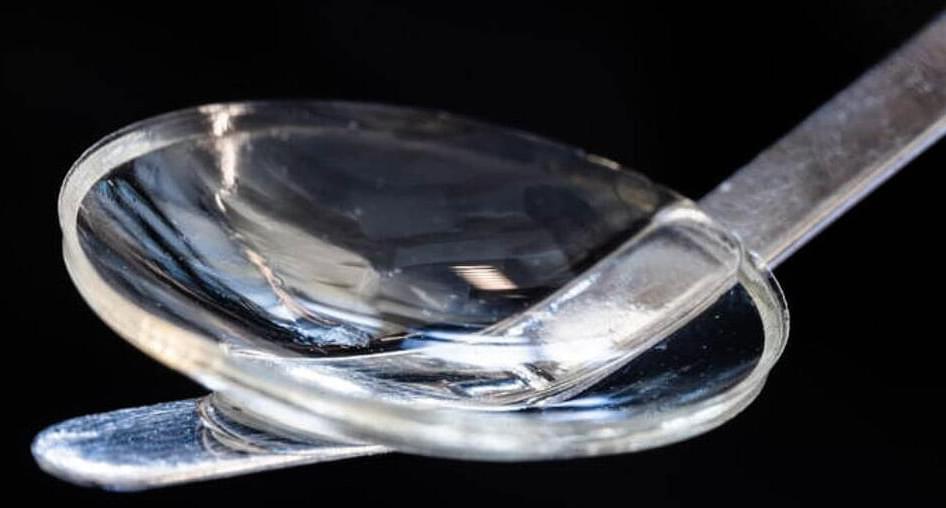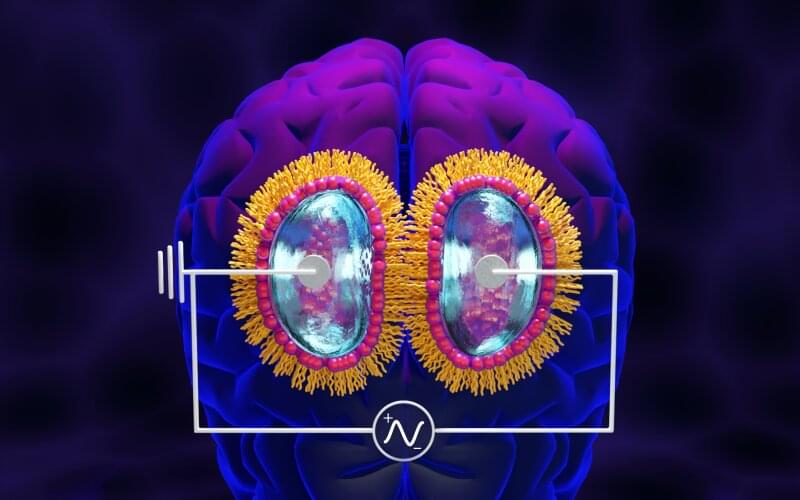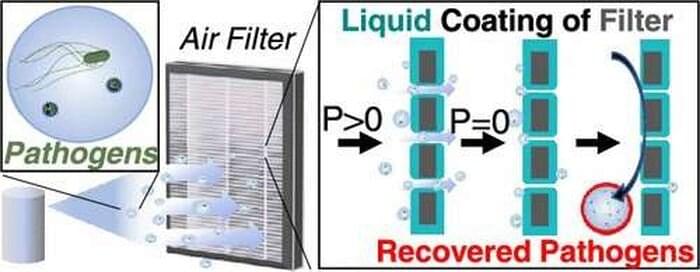This eye implant engineered from proteins in pig skin can restore sight in people with impaired eyesight as well as the blind.



While studying how bio-inspired materials might inform the design of next-generation computers, scientists at the Department of Energy’s Oak Ridge National Laboratory achieved a first-of-its-kind result that could have big implications for both edge computing and human health.
Results published in Proceedings of the National Academy of Sciences show that an artificial cell membrane is capable of long-term potentiation, or LTP, a hallmark of biological learning and memory. This is the first evidence that a cell membrane alone—without proteins or other biomolecules embedded within it—is capable of LTP that persists for many hours. It is also the first identified nanoscale structure in which memory can be encoded.
“When facilities were shut down as a result of COVID, this led us to pivot away from our usual membrane research,” said John Katsaras, a biophysicist in ORNL’s Neutron Sciences Directorate specializing in neutron scattering and the study of biological membranes at ORNL.
In the philosophy of mind, the multiple realizability thesis contends that a single mental kind (property, state, event) can be realized by many distinct physical kinds. A common example is pain. Many philosophers have asserted that a wide variety of physical properties, states, or events, sharing no features in common at that level of description, can all realize the same pain. This thesis served as a premise in the most influential argument against early theories that identified mental states with brain states (psychoneural, or mind-brain identity theories). It also served in early arguments for functionalism. Nonreductive physicalists later adopted this premise and these arguments (usually without alteration) to challenge all varieties of psychophysical reductionism. The argument was even used to challenge the functionalism it initially was offered to support. Reductionists (and other critics) quickly offered a number of responses, initially attacking either the anti-reductionist or anti-identity conclusion from the multiple realizability premise, or advocating accounts of the reduction relation that accommodated multiple realizability. More recently it has become fashionable to attack the multiple realizability premise itself. Most recently the first book-length treatment of multiple realizability and its philosophical import has appeared.
This entry proceeds mostly chronologically, to indicate the historical development of the topic. Its principle focus is on philosophy of mind and cognitive science, but it also indicates the more recent shift in emphasis to concerns in the metaphysics of science more generally. It is worth mentioning at the outset that multiple realizability has been claimed in physics (e.g., Batterman 2000), biochemistry (Tahko forthcoming) and synthetic biology (Koskinen 2019a, b). After more than fifty years of detailed philosophical discussion there still seems to be no end in sight for novel ideas about this persistent concern.

Imaging deep tissues with light is challenging. Visible light is often quickly absorbed and scattered by structures and molecules in the body, preventing researchers from seeing deeper than a millimeter within a tissue. If they do manage to probe further, substances like collagen or melanin often muddy the image, creating the equivalent of background noise through their natural fluorescence. As the authors explained, “Biological tissues have strong optical attenuation in the visible wavelength range (350–700 nm), due to the absorption of hemoglobin and melanin, as well as the tissue scattering, which fundamentally limits the imaging depth of high-resolution optical technologies.”
To wade out from these muddied waters, Yao and collaborator Vladislav Verkhusha, PhD, professor of genetics at Albert Einstein College of Medicine, developed a protein that absorbs and emits longer wavelengths of light in the near-infrared (NIR) spectrum. “Tissue is the most transparent in the 700‑1300 nm window of NIR light,” said Yao. “At those wavelengths, light can penetrate deeper into a tissue, and because there is less natural background fluorescence to filter out, we can take longer exposures and capture clearer images.”
Verkhusha and his lab used a process called directed molecular evolution to engineer their proteins, using photoreceptors normally found in bacteria as the basis for the structure. “The state-of-the-art NIR FPs were engineered from bacterial phytochrome photoreceptors (BphPs),” the team noted. “Applying rational design, we developed 17 kDa cyanobacteriochrome-based near-infrared (NIR-I) fluorescent protein, miRFP718nano.”

Researchers from the University of Maine and University of Massachusetts Amherst have designed new liquid-coated air filters that allow for improved early detection and analysis of airborne bacteria and viruses, including the one that causes COVID-19. The team has published their findings in the journal ACS Applied Materials & Interfaces.
While conventional air filters help control the spread of disease in public spaces like hospitals and travel hubs, they struggle to keep the pathogens they capture viable for testing. The inefficiency can inhibit scientists’ ability to identify biological threats early on, which could hinder any response and protection measures.
The research team, led by Caitlin Howell, a UMaine associate professor of biomedical engineering, developed a composite membrane with a liquid layer for filters that is better suited for capturing viable bacterial and viral samples for analysis. They modeled the membrane after the Nepenthes pitcher plant, which has a slippery rim and inner walls that cause insects to fall and become trapped within its digestive fluid. By keeping the bacteria and viruses they capture feasible for examination, researchers say their novel liquid-coated air filters can enhance air sampling efforts, early pathogen detection and biosurveillance for national security.

Researchers at McMaster University have created a powerful new weapon against bacterial contamination and infection.
They have developed a way to coax bacteriophages—harmless viruses that eat bacteria—into linking together and forming microscopic beads. Those beads can safely be applied to food and other materials to rid them of harmful pathogens such as E. coli 0157. Each bead is about 20 microns, (one 50th of a millimeter) in diameter and is loaded with millions of phages.
The McMaster engineering team behind the invention, led by professors Zeinab Hosseinidoust, who holds the Canada Research Chair in Bacteriophage Bioengineering, and Tohid Didar, who holds the Canada Research Chair in Nano-Biomaterials, and graduate student Lei Tian, have created a spray using nothing but the microbeads.
In a breakthrough study, Japanese researchers at Osaka Metropolitan University have engineered the smallest motile life form ever. They introduced seven bacterial proteins into a synthetic bacterium, allowing it to move independently.
The rise of synthetic biology.
The new study is based on the synthetic bacterium called syn-3. The tiny spherical bacteria contain minimal genetic information, allowing them to grow and divide without motility.
The team experimented with syn-3 by introducing seven genes that code for proteins that are likely involved in the swimming motion of Spiroplasma bacteria.
UA/Wikimedia Commons.

These fundamental units of the brain and nervous system – composed of the cell body, the dendrites and the axon (a long, thin extension responsible for communicating with other cells) – receive sensory input from the external world, send motor commands to our muscles and for transform and relay the electrical signals at every step in between.
“Our novel method of creating ‘mini-brains’ opens the door to finding solutions for various neurological impairments”
Prof. Orit Shefi and doctoral student Reut Plen from the Kofkin Faculty of Engineering at Bar-Ilan University (BIU) have developed a novel technique to overcome this challenge using nanotechnology and magnetic manipulations – one of the most innovative approaches to creating neural networks. Their research was recently published in the peer-reviewed journal Advanced Functional Materials under the title “Bioengineering 3D Neural Networks Using Magnetic Manipulations.”
Ray Kurzweil is an author, computer scientist, inventor, futurist and a director of engineering at Google. Kurzweil is a public advocate for the futurist and transhumanist movements, and gives public talks to share his optimistic outlook on life extension technologies and the future of nanotechnology, robotics, and biotechnology.
Recorded 2013

Steven Parton [00:00:37] Hello everyone. My name is Steven Parton and you are listening to the feedback loop on Singularity Radio. This week our guest is business and technology reporter Peter Ward. Earlier this year, Peter released his book The Price of Immortality The Race to Live Forever, where he investigates the many movements and organizations that are seeking to increase the human lifespan from the Church of Perpetual Life in Florida to some of the biggest tech giants in Silicon Valley. In this episode, we explore Peter’s findings, which takes us on a tour from cryogenics to mind uploading from supplements to gene editing and much more. Along the way, we discuss the details of how one might actually achieve immortality, talking about senescent cells and telomeres. Discussing whether it’s better to live healthy than to live long. We also discuss the scams and failures that seem to dominate the longevity space, as well as the efforts that seem the most promising. And now, since we’re on the topic of discussing how precious life is, are waste no more of your precious time? So everyone, please welcome to the feedback loop. Peter Ward. Well then, Peter, thanks for joining me. I think the best place to start is in April of this year. You released a book called The Price of Immortality The Race to Live Forever and where I love to start with anyone who’s written a book is just hearing about your motivations for the book. Why did you decide that this was a topic worth exploring?